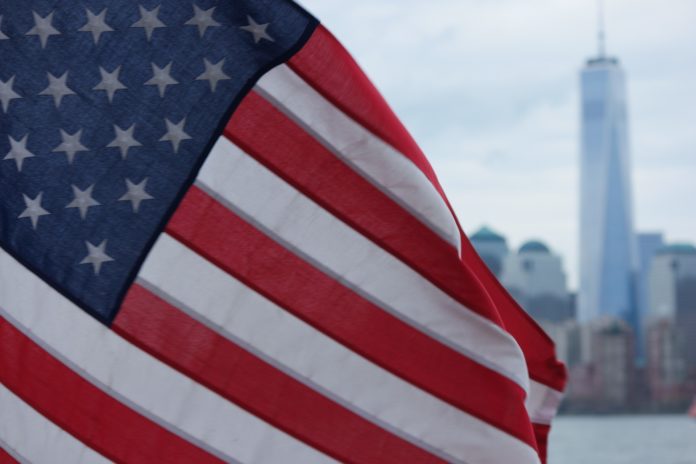Eighteen years ago today, the United States came under direct attack by a foreign enemy in an attack some have called the Pearl Harbor of our generation.
American Airlines Flight 11, carrying 76 passengers and a crew of 11, after being hijacked by members of the Islamic terrorist group Al Qaeda, at 8:46 a.m. Eastern Time (7:46 Central), struck the north tower of the World Trade Center in downtown New York City. Seventeen minutes later, United Airlines Flight 175 struck the south tower with 51 passengers and nine crew members aboard. Both buildings collapsed a short time later. At 9:37 a.m., American Airlines Flight 77, with six crew members and 53 passengers, struck the Pentagon in Arlington, Virginia, just outside Washington D.C. These numbers do not include the hijackers.
Beginning of the War on Terror: Flight 93
United Airlines Flight 93, carrying 33 passengers and seven crew members from New Jersey to California, was hijacked at 9:28 a.m., shortly before the Pentagon crash. Its target was a hijackers’ choice of the Capitol Building or White House. Passengers and crew, communicating with family members and authorities on the ground, learned of the other attacks and determined by a vote taken in the back of the passenger compartment that their plane would not reach its target. Passenger Todd Beamer, on an airphone call to a network operator shortly before 10:00, after reciting the Lord’s Prayer and 23rd Psalm, was heard saying to fellow passengers, “Let’s roll.”
Passengers and crew stormed the cockpit at 9:57, fighting their way past a guard posted outside the door, using a food cart as a battering ram and creative improvised weapons like coffee pots of hot water. At 10:03, Flight 93 went down near Stonycreek, Pennsylvania, killing four terrorists and saving lives at their targets, still 130 miles away. America’s response to Al Qaeda had begun while the fires of their first attacks were still burning.
The numbers
There is debate over the statistics; these are widely accepted.
Excluding the hijackers, 2,977 people died in the 9/11 attacks, including:
-
2,606 at the World Trade Center
-
246 airline passengers and crew
-
125 at the Pentago
These numbers include 343 firefighters, 72 law enforcement officers (71 in New York, and one in the Flight 93 crash) and 55 U.S. military personnel.
More than 6,000 people were injured in the attacks.
Aftermath: 9/11-related medical conditions
In a 2010 study by the New York City Fire Department of 5,000 rescue workers who had worked at the World Trade Center site during rescue and recovery operations, all participants were found to suffer from diminished lung function. The effects have gone far beyond that.
The Centers for Disease Control and Prevention (CDC) has identified hundreds of types and subtypes of cancer associated with exposure to materials released during the destruction of buildings in the 9/11 attacks, along with musculoskeletal, mental and aerodigestive disorders.
As of June 2019, the CDC World Trade Center Health Program reported an enrollment of over 97,000 certified applicants, including 76,050 emergency responders and 21,636 other survivors. Of these, 2,448 are deceased. Over 200 firefighters and over 240 law enforcement officers from New York City alone have died from health effects of their service.
War on Terror
Since 2001, U.S. and allied forces have been involved in ongoing military operations against Islamic militants and others around the world, starting in Afghanistan where Al Qaeda’s 9/11 agents were based. In moves that were sometimes controversial, actions spread to Iraq, Syria, Pakistan, Yemen, Somalia, the Philippines and other locations.
Statistics (including the 9/11 attacks)
-
The total cost to the U.S. and allies is estimated to be more than $5 trillion.
-
More than 10,000 Americans have been killed.
-
More than 56,000 Americans have been wounded or injured.
-
Terrorist/insurgent/Islamic militant deaths are estimated at 350,000 or more.
-
According to the VA, approximately 200,000 U.S. veterans have been diagnosed with PTSD since 2001.
Alabamians in the War on Terror
CIA agent Mike Spann, from Winfield, was killed during a fight with Taliban prisoners of war in Afghanistan on Nov. 25, 2001, and is widely regarded as the first American combat casualty of the War on Terror. Alabama’s response to the 9/11 attacks began even earlier though, with active homeland security operations in the U.S. as early as Sept. 14, 2001. The state’s role in the war has been extensive: at times, Alabama’s commitment of National Guard Troops has been the second largest of any state in the nation, behind only Texas. The following list of Alabama units deployed as part of the War on Terror is not exhaustive, but the sampling points out the extent of the state’s contribution.
Army National Guard
-
167th Infantry Regiment, whose Company C is based in Cullman
-
1st Battalion 117th Field Artillery Regiment
-
152nd Military Police Company
-
214th Military Police Company
-
217th Military Police Company
-
1165th Military Police Company
-
20th Special Forces Group, whose 1st Battalion is based in Alabama
-
877th Engineer Battalion
-
Alabama Army National Guard Joint Force Headquarters Forward Logistics Team Four
-
Alabama Army National Guard Joint Force Headquarters Forward Logistics Team Six
-
1200th Combat Sustainment Support Battalion
-
1st Battalion, 131st Aviation Regiment
-
Company B, 169th Aviation Battalion
-
Company B, 1024th Aviation Support Battalion
-
135th Expeditionary Sustainment Command
-
115th Expeditionary Signal Battalion
-
136th Expeditionary Signal Battalion
-
1207th Quartermaster Detachment
-
128th Medical Company
-
129th Medical Company
-
158th Maintenance Company
-
151st Chemical Battalion
-
1343rd Chemical Battalion
-
1670th Transportation Company
-
2025th Transportation Company
-
2101st Transportation Company
-
203rd Military Police Battalion
-
441st Explosive Ordnance Disposal Battalion
Army Reserve
-
926th Engineer Brigade
-
498th Transportation Company
-
813th Replacement Company
Air National Guard
-
100th Expeditionary Fighter Squadron
-
117th Aviation Refueling Wing – supported homeland security operations immediately following the 9/11 attacks, and was nationally recognized for maintaining a constant airborne presence over the southeast U.S. from Sept. 14-28, 2001.
-
187th Fighter Wing
Naval Reserve
-
Navy Cargo Handling Battalion 12
-
Naval Mobile Construction Battalion 24



























